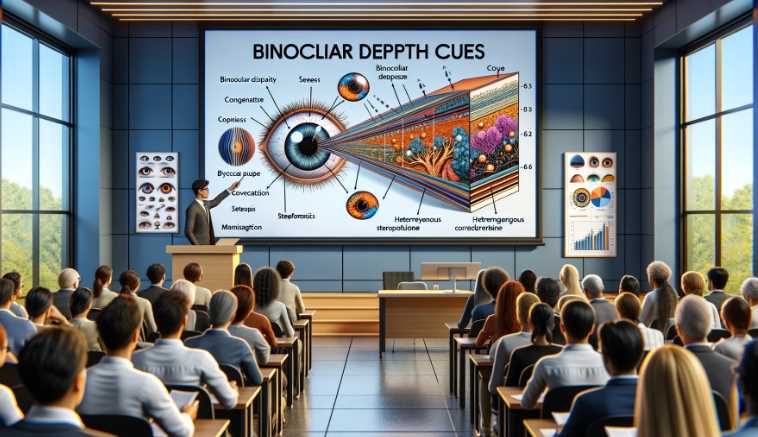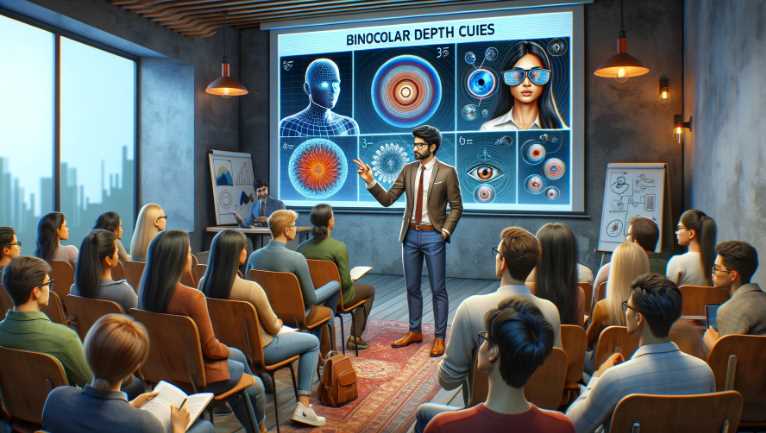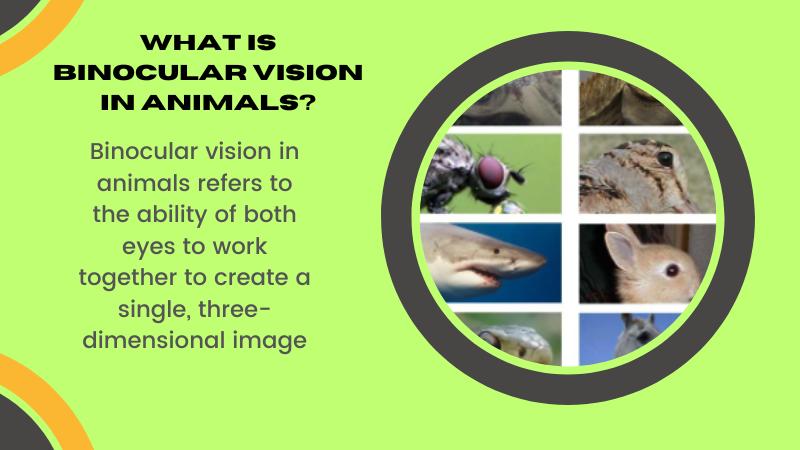Binocular depth cues are visual information derived from the different perspectives of both eyes, contributing to the perception of depth and distance.
In psychology, depth perception refers to the ability to perceive the world in three dimensions, allowing us to gauge distances and perceive objects in space. Binocular depth cues rely on the unique perspectives of each eye to provide the brain with information about the relative distance of objects. These cues are particularly important for accurate depth perception near the observer.
Binocular depth cues include:
- Retinal Disparity:
- Definition: The slight difference in the retinal image location of an object between the two eyes.
- Effect: Greater retinal disparity indicates closer objects, while lesser disparity suggests greater distance.
- Convergence:
- Definition: The degree to which the eyes turn inward to focus on a close object.
- Effect: Greater convergence is required for closer objects, and less convergence for more distant ones.
| Binocular Depth Cue | Definition | Effect on Perception |
|---|---|---|
| Retinal Disparity | Slight difference in retinal image location | Greater disparity indicates closer objects; lesser disparity for more distant ones. |
| Convergence | Inward turning of eyes for close objects | Greater convergence for closer objects; less convergence for more distant ones. |
Understanding these binocular depth cues helps psychologists and researchers explore the mechanisms behind human depth perception and how the brain integrates information from both eyes to create a three-dimensional perceptual experience.

Types of Binocular Depth Cues
Binocular Disparity
One of the primary players in this visual symphony is binocular disparity. Picture this: each eye capturing a slightly different image, and our brain skillfully fusing these perspectives to create a rich, three-dimensional tapestry. This phenomenon plays out in countless scenarios, from gauging distances to reaching out for objects.
Convergence
As I explore the concept of convergence, I’m struck by its role in eye movement. The subtle adjustments our eyes make to focus on an object reveal the intricate choreography behind depth perception. Everyday tasks, like reading or driving, become a testament to the marvel of convergence.
Stereopsis
Stereopsis emerges as a captivating aspect of binocular depth cues. The idea that our brain combines two images, ever so slightly different, to construct a vivid perception of depth opens a window into the marvels of our cognitive processes. It’s almost like a cinematic experience playing out in our minds.
Accommodation
Accommodation, though often overlooked, plays a crucial role in our visual narrative. The way our eyes adjust focus to perceive depth is akin to a camera lens finding the perfect clarity. As I reflect on this, I’m reminded of moments when sharp focus enhances my perception of the world.
Interactions Between Binocular Cues
Integration of Cues
The integration of these cues forms the backbone of our holistic spatial awareness. It’s akin to a masterful orchestration, each cue complementing the other to create a seamless perception of the world. Our brains, the conductors in this symphony, blend these cues effortlessly.
Development of Binocular Depth Perception
Infancy and Childhood
As a parent, witnessing the development of binocular depth perception in my child has been a joyous experience. Those early attempts at reaching for objects, the gleam in their eyes as they grasp the concept—each moment is a testament to the importance of binocular vision in cognitive and motor development.
Adulthood and Aging
Moving into adulthood, I’m acutely aware of the changes in binocular depth perception that accompany the passage of time. Understanding these shifts becomes crucial, not only for personal awareness but also in addressing the potential impact on daily activities and overall quality of life.
Clinical Applications
Vision Disorders
Navigating the realm of vision disorders, such as strabismus and amblyopia, takes on a personal note as I consider the impact on individuals. The exploration of therapeutic interventions becomes a journey into the ways we can enhance and restore binocular vision for a better quality of life.
Rehabilitation and Training
Discovering rehabilitation programs has added a layer of optimism to my understanding. Witnessing individuals regain their binocular vision through targeted exercises and interventions is a testament to the resilience of the human brain and the potential for improvement.
Technology and Binocular Depth Cues
Virtual Reality
Stepping into the world of virtual reality feels like a voyage into the future. Understanding how binocular depth cues contribute to the immersive experiences in VR highlights the exciting possibilities for gaming, training, and simulations. It’s a glimpse into a realm where technology mirrors the intricacies of our perception.
3D Technology
Delving into the world of 3D technology, I ponder the implications for filmmakers and technologists. How they leverage binocular cues to create realistic visual experiences is akin to painting with an expanded palette. Yet, it’s essential to recognize the challenges and potential drawbacks that accompany the mesmerizing allure of 3D.
Research and Discoveries
Recent Studies
The excitement of recent scientific studies on binocular depth cues resonates with me. Each breakthrough, each new finding, fuels my curiosity about the intricacies of our perception. It’s a thrilling time to witness the merging of neuroscience and psychology to unlock the secrets of our visual world.
Ongoing Research
The anticipation surrounding ongoing research adds a layer of excitement to my exploration. Imagining the possibilities of uncovering new facets of how the brain processes depth information fuels my curiosity. The promise of breakthroughs looms on the horizon, promising to reshape our understanding of psychology.
What are binocular depth cues and how do they work?
Binocular depth cues are visual cues that depend on the use of both eyes and play a crucial role in depth perception. These cues arise from the slight disparity in the images projected onto each retina, allowing the brain to interpret the differences and perceive depth.
| Term | Definition |
|---|---|
| Retinal Disparity | The slight difference in the images projected onto each retina, providing information about the depth of an object. |
How do convergence and divergence contribute to binocular depth perception?
Convergence and divergence refer to the movement of the eyes to focus on an object. Convergence occurs when both eyes turn inward to focus on a nearby object, while divergence happens when they turn outward for more distant objects. These movements help the brain determine an object’s distance.
| Term | Description |
|---|---|
| Convergence | The inward movement of both eyes to focus on a near object. |
| Divergence | The outward movement of both eyes to focus on a distant object. |
What is stereopsis, and how does it relate to binocular depth perception?
Stereopsis is the ability to perceive three-dimensional depth by merging the slightly disparate images from each eye. This process relies on the brain’s interpretation of the retinal disparity, enhancing the perception of depth and solidifying the sense of spatial relationships.
| Term | Explanation |
|---|---|
| Stereopsis | The ability to perceive depth and solidity based on the slight differences in the images projected onto each retina. |
Can binocular depth cues be influenced by visual disorders or impairments?
Yes, visual disorders or impairments can affect binocular depth perception. Conditions such as strabismus (crossed eyes) or amblyopia (lazy eye) can disrupt the normal functioning of binocular cues, leading to difficulties in perceiving depth accurately.
| Condition | Impact on Binocular Depth Cues |
|---|---|
| Strabismus | Crossed eyes may result in impaired convergence and affect depth perception. |
| Amblyopia | Lazy eye can disrupt the synchronization of both eyes, impacting stereopsis. |
Do binocular depth cues play a role in virtual reality experiences?
Yes, binocular depth cues play a crucial role in enhancing the realism of virtual reality (VR) experiences. VR systems are designed to simulate natural binocular cues, such as retinal disparity and convergence, to create a more immersive and authentic sense of depth and space.
| VR Application | Utilization of Binocular Depth Cues |
|---|---|
| Virtual Reality | Incorporates retinal disparity and convergence to enhance depth perception in simulated environments. |
How do binocular depth cues contribute to the “horopter” in vision?

The horopter is an imaginary surface in space where objects appear single when fixated. Binocular depth cues, such as retinal disparity and convergence, help establish the horopter by ensuring that corresponding points in both eyes fall on this surface, allowing for a cohesive and accurate fusion of visual information.
| Term | Role in Establishing the Horopter |
|---|---|
| Horopter | The imaginary surface where objects appear single when fixated, influenced by binocular depth cues. |
Can the perception of depth using binocular cues be trained or developed?
Yes, the perception of depth through binocular cues can be trained and developed. Vision therapy, which includes exercises to improve convergence, divergence, and stereopsis, can be employed to enhance binocular vision and address issues related to depth perception.
| Approach | Impact on Binocular Depth Perception Training |
|---|---|
| Vision Therapy | Exercises targeting convergence, divergence, and stereopsis can improve depth perception over time. |
Are there situations where monocular depth cues are more dominant than binocular cues?
Yes, certain situations emphasize monocular depth cues over binocular cues. For example, when viewing objects at a great distance, monocular cues such as relative size, interposition, and linear perspective become more prominent due to the minimal disparity between the images on each retina.
| Scenario | Dominant Depth Cues |
|---|---|
| Distance Viewing | Monocular cues like relative size and linear perspective become more noticeable as binocular disparity decreases. |
How do age-related changes in vision impact binocular depth perception?
As individuals age, changes in vision, such as presbyopia (age-related farsightedness) and reduced accommodation ability, can affect binocular depth perception. These age-related changes may impact the ability to converge or diverge the eyes effectively, influencing the overall perception of depth.
| Age-Related Change | Impact on Binocular Depth Perception |
|---|---|
| Presbyopia | Age-related farsightedness may affect accommodation and impact binocular cues. |
Do animals rely on binocular depth cues in the same way humans do?
While some animals share similar binocular depth cues with humans, the importance and utilization of these cues vary across species. Predatory animals, for instance, often rely heavily on binocular vision for depth perception, aiding in tasks such as hunting and capturing prey.
| Animal | Utilization of Binocular Depth Cues |
|---|---|
| Predatory Animals | Many rely on binocular vision for accurate depth perception during hunting activities. |
Understanding binocular depth cues is not only essential in the field of psychology but also has practical implications in fields like ophthalmology, virtual reality development, and vision therapy. As our understanding of these cues advances, so does our ability to improve visual experiences and address vision-related challenges.
Conclusion
In wrapping up this exploration of binocular depth cues, I find myself marveling at the richness of our perceptual experiences. The journey from understanding the basics to delving into applications and research has been akin to unlocking a treasure trove of knowledge. As we continue to probe the depths of psychology, the story of binocular depth cues remains an integral chapter, one that continues to unfold.
References:
- Gibson, J. J. (1950). The Perception of the Visual World. Boston: Houghton Mifflin.
- Howard, I. P., & Rogers, B. J. (2002). Seeing in Depth. Toronto: I Porteous.
- Blake, R., & Sekuler, R. (2006). Perception. New York: McGraw-Hill.
- Held, R., & Hein, A. (1963). Movement-Produced Stimulation in the Development of Visually Guided Behavior. Journal of Comparative and Physiological Psychology, 56(5), 872–876.

Fahim Foysal is a well-known expert in the field of binoculars, with a passion for exploring the great outdoors and observing nature up close. With years of experience in the field, Fahim has honed his skills as a binocular user and has become a go-to resource for those seeking advice on choosing the right binoculars for their needs.
Fahim’s love for the natural world began during his time at The Millennium Stars School and College and BIAM Laboratory School, where he spent much of his free time exploring the outdoors and observing the wildlife around him. This passion for nature led him to pursue a degree in Fine Arts from the University of Dhaka, where he gained a deep understanding of the importance of observation and attention to detail.
Throughout his career, Fahim has used his expertise in binoculars to help others discover the beauty of the natural world. His extensive knowledge of binocular technology and optics has made him a trusted advisor for amateur and professional wildlife observers alike. Whether you’re looking to spot rare birds or observe animals in their natural habitats, Fahim can help you choose the perfect binoculars for your needs. With his guidance, you’ll be able to explore the outdoors with a newfound appreciation for the beauty of the natural world.
Table of Contents

Pingback: What is the difference between monocular and binocular depth cues?
Pingback: Why is the binocular depth system advantageous for predators?